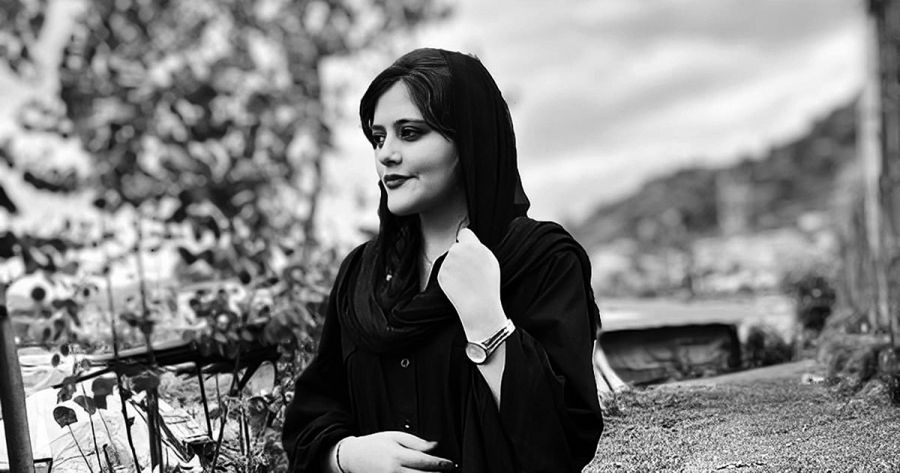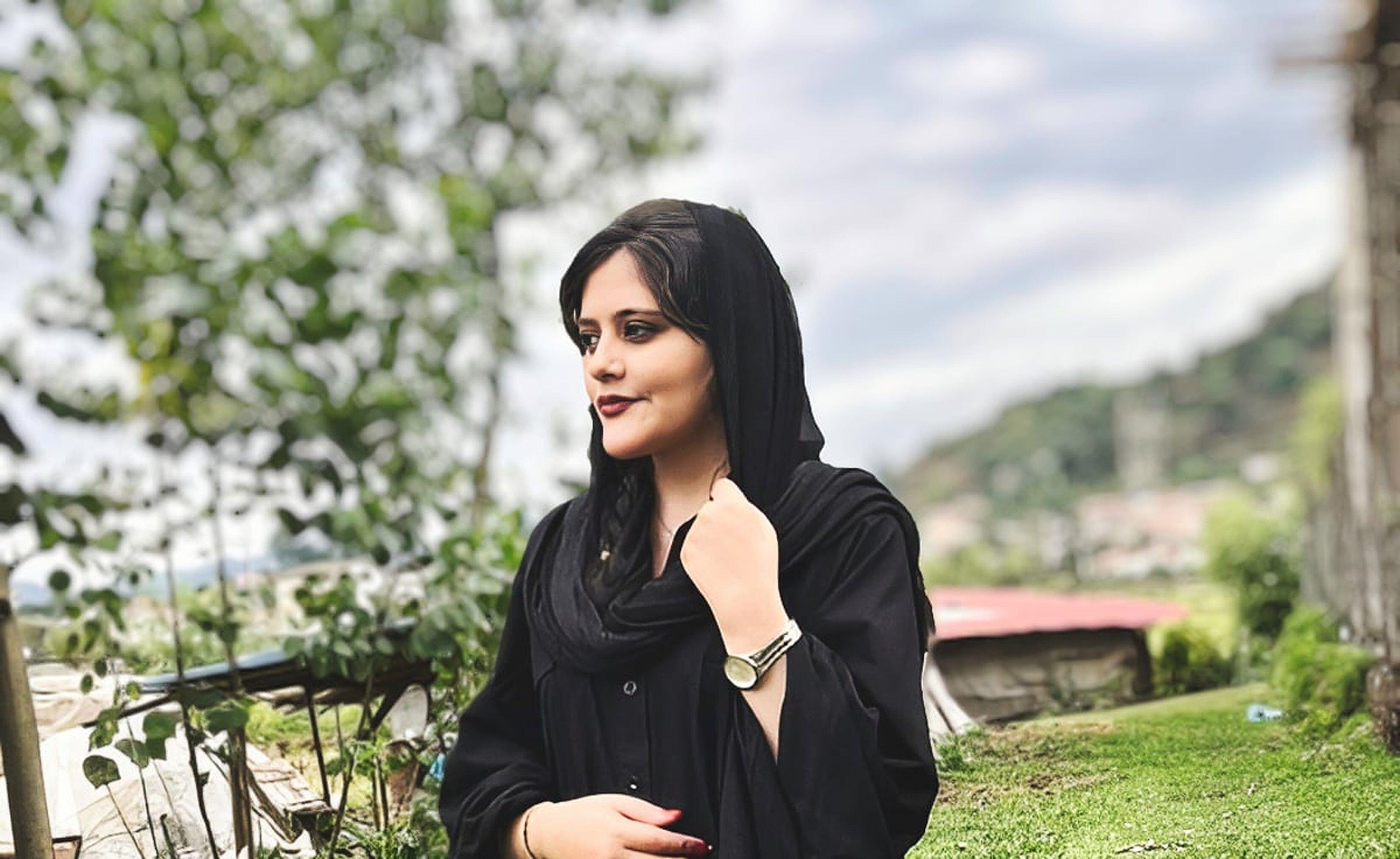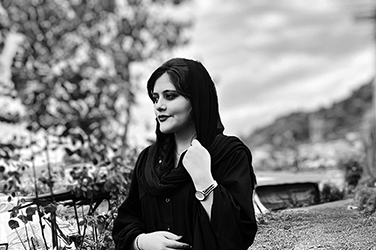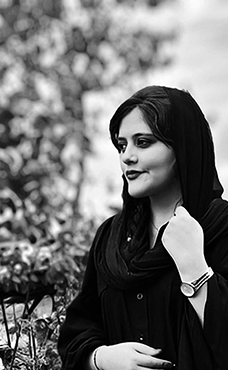
- Free Article: No
- Contents Category: Commentary
- Custom Article Title: 'Call it a revolution'
- Review Article: No
- Article Title: 'Call it a revolution'
- Article Subtitle: From falling veils to a failing regime
- Online Only: No
- Custom Highlight Text:
With protests by members of the Iranian diaspora burgeoning across Europe and the rest of the world, I attend a demonstration in central Athens. A group assembles in front of the Greek Parliament, with two banners outstretched. The first reads ‘Woman, Life, Freedom’, the second, ‘the Iranian people no longer want the Islamic Republic’. The mise en scène seems to capture the genealogy of a movement that began with the death of a twenty-two-year-old Kurdish woman, Jina (or Mahsa) Amini, on 16 September in Tehran following her arrest by the notorious morality police, and has since grown into what has been deemed the biggest domestic threat yet to the existence of the Islamic regime.
- Article Hero Image (920px wide):

- Article Hero Image Caption: Mahsa Amini (ZUMA Press, Inc./Alamy)
- Featured Image (400px * 250px):

- Alt Tag (Featured Image): Zoe Holman on resistance in Iran
This is by no means the first case of feminist mobilisation in the country’s modern history. In 1936, the move by Iran’s Western-backed ruler, Reza Shah Pahlavi, to mandate unveiling as part of a ‘modernisation’ campaign stoked the outrage of women in Iran, many of whom were excluded from work and educational opportunities, or faced punitive, often violent retribution by police for veiling. With the 1979 overthrow of the monarchy, women’s bodies remained at the forefront of the ideological agenda, as the country’s new theocratic rulers, led by Ayatollah Khomeini, sought to domesticate and traditionalise female citizens as a key pillar of its Islamisation program. Just as the first written laws of the nascent Islamic Republic enforced the wearing of hijab, the first protests of the pre-revolutionary era saw women decrying the withdrawal of their rights with chants of ‘In the dawn of freedom, there is an absence of freedom’.
This objection to the continued denial of women’s personal liberty has fuelled the campaign against mandatory dress codes in the twenty-first century, as conformity (of lack thereof) with conservative veiling practices continues to dictate women’s employment opportunities, particularly in the public service. (Women make up more than half of Iran’s university graduates but only around sixteen per cent of its labour force – a disparity that reflects discrimination around personal dress codes.) In 2006, female activists launched the so-called ‘One Million Signatures’ petition to abolish Iran’s iniquitous hijab laws. Many of them were subsequently attacked and imprisoned.
Despite being a focal point, mandatory veiling has not been the sole or paramount concern of Iranian feminists, but has instead formed part of a broader campaign of awareness-raising and opposition to the systemic inequities of a patriarchal regime. The insurrection unleashed in September also reflects popular outrage at injustices that go far beyond the violent enforcement of dress codes. Where Amini has provided an emblem with which many Iranians can identify – she could, after all, have been anyone’s daughter or sister – her death has triggered the expression of myriad and escalating grievances. ‘Amini’s death could be likened to an earthquake – finally all the energy that has built up is released,’ Sydney-based Iranian academic Setayesh Nooraninejad tells me. ‘A society under economic pressure over several decades, severely from international sanctions, and with the accumulating types of dissatisfaction, suddenly caught fire. Now the people of Iran are protesting more broadly against the entire way of governance.’
Indeed, what also distinguishes the current mobilisation is its geographic, social, and political breadth. Anti-government protest has not been limited to Iran’s major cities or secular middle classes, but has filtered through economic and demographic tiers, as was reinforced last month with the closure by protesting vendors of Tehran’s iconic Grand Bazaar, an attack on the home of Ayatollah Khomeini, strikes across sectors including trucking, nursing, oil and gas, and the high-profile refusal of the Iranian soccer team to sing the national anthem at the World Cup in Qatar. The upheaval has been nationwide. Many of the most fervent protests and deadliest crackdowns have occurred in Iran’s provincial strongholds of opposition, most notably Kurdistan and southern Sistan and Baluchistan, where a protest on 30 September in the city of Zehedan against Amini’s death and the alleged rape by a police commander of a fifteen-year-old Baluchi girl resulted in dozens of people being killed with live ammunition in an event dubbed ‘Bloody Friday’.
It is this ruthless intransigence by the security forces, coupled with economic grievances, that has fomented an unprecedented intersectional opposition to the regime, drawing in those who might ordinarily have expressed political or religious affiliation with Iran’s leadership. Unlike the urban-based Green Movement of 2009, which demanded the holding to account of the government, discontent has since billowed into a more generalised demand for the very abolition of the government in its current form. Where 2009 saw demonstrators take to rooftops in major cities nightly with calls of ‘Allahu Akbar’, the widespread rallying cry is now ‘Down with the Islamic regime’. As Canberra-based Iranian activist Maryam Khazaeli Dobson says, ‘Since Bloody November of 2019, we can see that the working classes are more engaged, as none of the promises by Ahmadinejad or Rouhani have come true.’
Similarly, although Iran’s population is the most secular in the region, developments since September have alienated many adherents of Islam who have come to see the government’s coercion (more typical of a Saudi-style Wahhabi brand of Islam) and brutality as undermining their religion. ‘Even those who choose to wear hijab have expressed sympathy and solidarity because they live in a patriarchal society that has forced other things on them. The government’s ideology has become one of force and violence and this is seen as having damaged Islam,’ says Khazaeli Dobson. ‘No matter if they live in a big city or small town, are employed or unemployed, I hear from everyone I talk to that the regime has fallen in people’s minds.’
Despite the unity of many of the protest slogans, the movement is not without internal fissures. For while Amini could seemingly have been any ordinary young woman in Iran, she was not. It is her Kurdish identity that is telling. First, the violence signified by her death was not that of gendered oppression alone, but also of a national oppression by the Islamic regime that has continuously subjected Iran’s national minorities – comprising an estimated half of the total population – to cultural assimilation and economic deprivation. It is this discrimination that compels many of Iran’s some ten million Kurds, like Amini, to adopt administrative names alongside their given family names. The fact that her Persian name ‘Mahsa’, not her Kurdish name ‘Jina’, has been used most widely in protests and media coverage speaks to the ongoing erasure and marginalisation of a Kurdish struggle whose proponents make up almost half of Iran’s political prisoners – some of them among the longest-serving. ‘This parenthesised naming is a continuity of national oppression under more than forty years of rule,’ explains Shahrzad Mojab, professor of women’s and gender studies at the University of Toronto, who participated in the Kurdish movement in Iran before being forced into exile.
The defining slogan of ‘Woman, life, freedom’ has its genesis in the Kurdish women’s movement, which originated in the struggle of the Kurdistan Workers’ Party (or PKK) against the colonial and patriarchal Turkish state. As Mojab notes, Kurdish women in Iran have publicly opposed the Islamic regime since its inception. Since the 1990s, a distinctive women’s civil-society activism has evolved. While solidarity between Kurdish women and those active in the rest of Iran has been limited, the recent uprisings indicate a shift. ‘The strong nationalism is a force to be reckoned with, but at the same time the level of unity that is happening now is unparalleled,’ says Mojab, noting how concerted campaigns to use Jina’s name in protests and slogans calling for uprising ‘from Kurdistan to Baluchistan’ reflect the fact that many Iranians are now looking to Kurdistan as a beacon of resistance.
Such forms of recognition will be essential if the current mobilisation is to cohere into a movement that at once opposes internal and state-sponsored gender oppression while also pursuing broader questions of national rights. Equally, the unity, autonomy, and internationalism of this struggle will be crucial if it is to successfully resist co-option by Western liberal agendas – either those of geopolitical interests or a colonial feminism (often promulgated by Iranian diaspora campaigners) that locates the struggle within the specific culture and traditions of Islam.
Whatever direction the protests might take, it is clear that the movement has long passed the point of no return. As many women now go about their lives bareheaded and unpenalised in Tehran’s main boulevards and cafés, it is clear that the campaign has ushered in changes that cannot be undone. Claims in December by senior officials that the morality police would be disbanded suggest a rhetorical acknowledgment of these new realities. Yet the regime’s subsequent mixed messaging about the status of the unit and mandatory hijab laws provoked staged walkouts by shopkeepers and drivers in more than forty cities following calls for a three-day national strike. It remains unclear what concessions Iran’s leaders will be willing to make in changing the core tenets of the Islamic Republic – if the republic is to survive at all. Since the outset of protests, the regime has stuck firmly to its standard playbook of tactics. Ayatollah Ali Khamenei, Iran’s supreme leader since 1989, has blamed the unrest on agitation by the usual suspects: Iran’s foreign adversaries; the United States and Israel; the ‘dregs’ of the Shah’s regime; domestic separatists. The regime has attempted to sever communications between protesters and the outside world (for example, the journalist who broke the story of Amini’s death was promptly detained in Iran’s notorious Evin Prison). Its parliament has urged the judiciary to deliver harsher, swifter punishments to protesters, including capital punishment. Two protesters have already been publicly hanged and at least a score more face death sentences in sham trials.
The momentum of protests being undiminished, the regime’s use of force appears a sign more of weakness than of strength. At the same time, Iran’s discredited political reformers – lagging woefully behind popular demands in what some see as a bid to maintain a share in political power – have largely alienated protesters. This has only intensified calls for wholesale regime change. Such a prospect, however, remains highly speculative in logistical terms, and not without the risk of a Syria-style ‘Assad or we burn the country’ fight to the end by the regime.
Western governments, meanwhile, have for the most part responded with well-worn statements of condemnation and threats of escalating the existing, indiscriminate economic sanctions that have only suffocated livelihoods and fuelled discontent among Iran’s population. Any local efforts at endogenous political change also remain at risk of exploitation by an opportunist and interventionist West with its baleful record of imperialist regime change in the region. In videos posted on social media, university students chant, ‘Don’t call it a protest, call it a revolution’. Whether or not that end can be realised, it is clear that the movement’s legacy will be irreversibly revolutionary.
This commentary is generously supported by the Copyright Agency’s Cultural Fund.



Comments powered by CComment